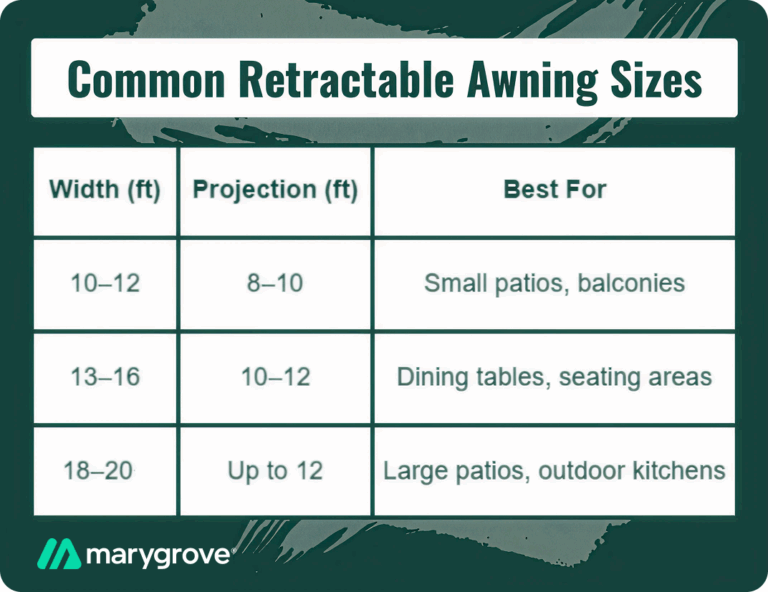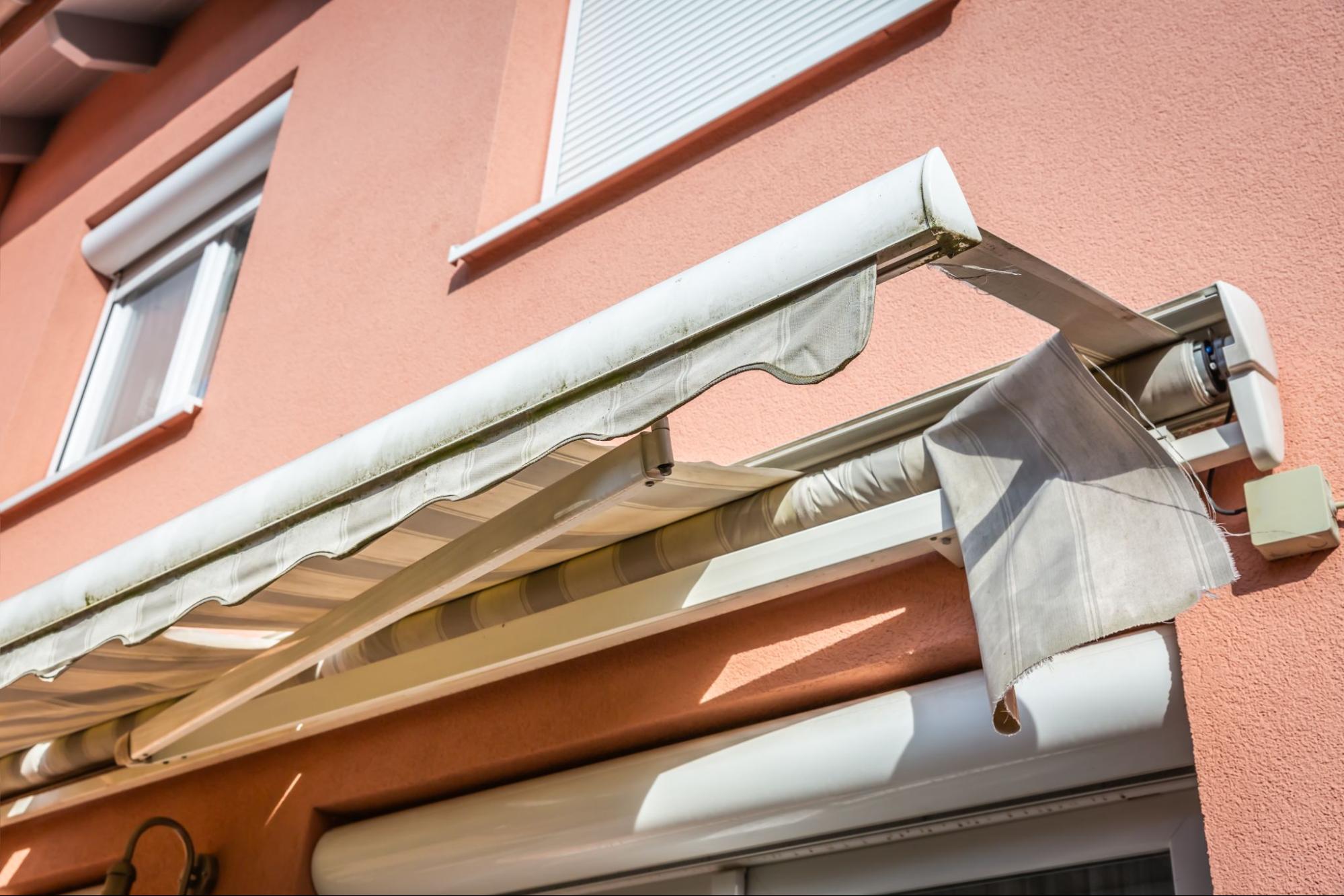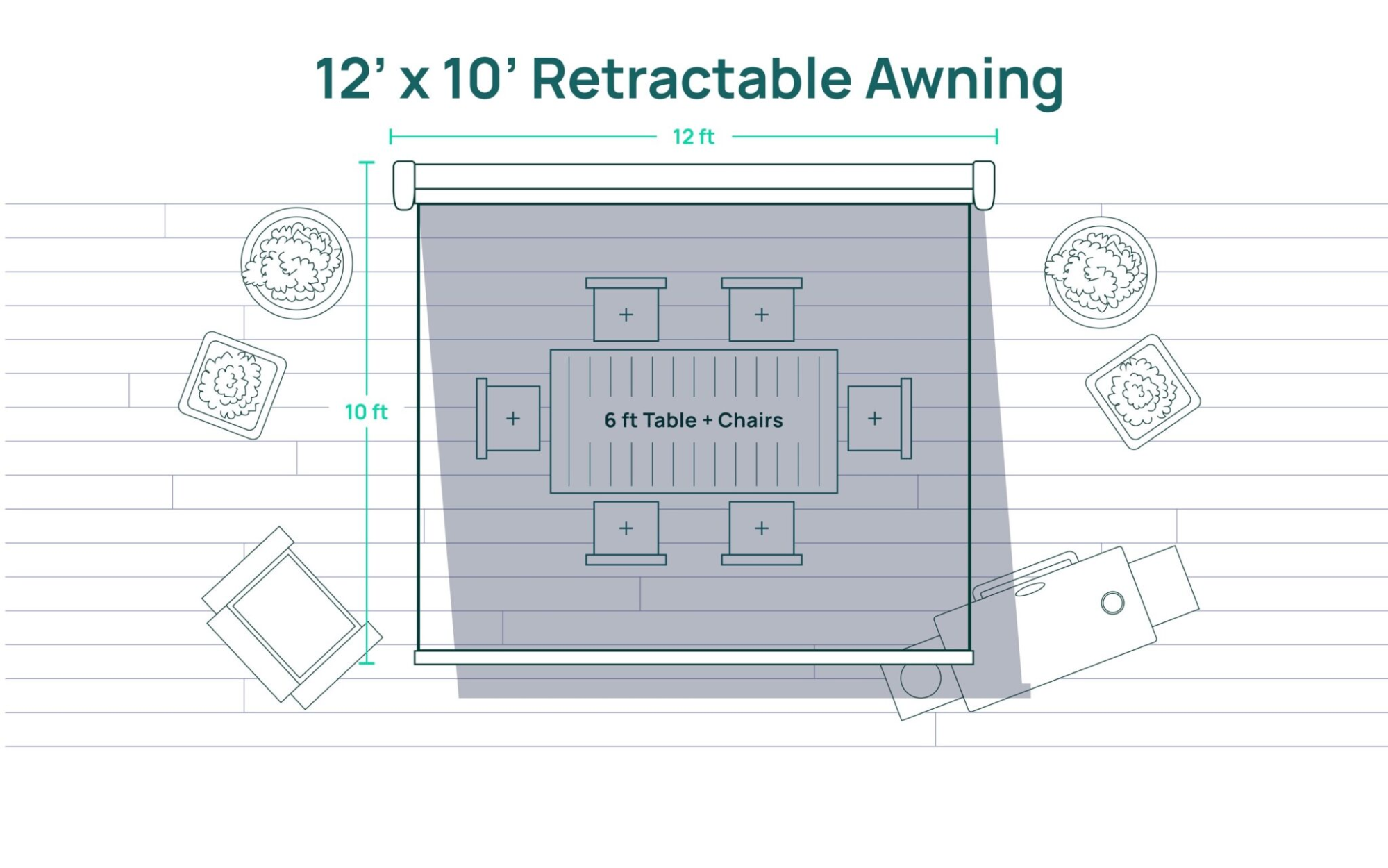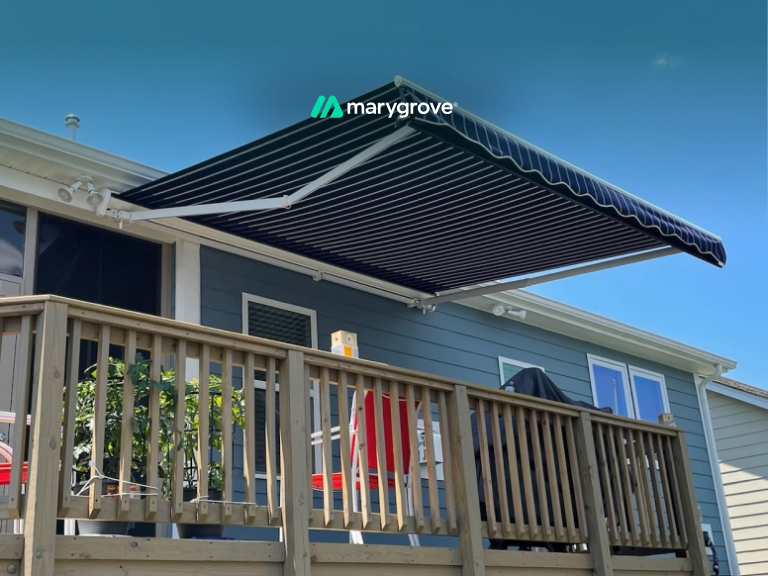Retractable awnings typically extend 8–12 feet for homes and up to 20 feet for larger spaces. Anything beyond 12 feet often requires commercial-grade engineering and risks wind damage, frame strain, and mounting failure.
How Far Can a Retractable Awning Extend? Key Points at a Glance
A retractable awning’s extension depends on several factors that balance shade, safety, and durability:
- Residential range: 8–12 ft suits most patios and decks.
- Larger setups: 15–20 ft possible with reinforced frames and secure anchoring.
- Unsafe beyond 20 ft: High risk of wind damage and structural strain.
- Pitch rule: A 3/12 slope (3-inch drop per foot) prevents rain pooling.
- Critical factors: Wall strength, mounting height, frame design, fabric durability, and wind exposure.
A well-sized awning maximizes shade without overloading your wall or frame. Professional installation ensures correct pitch, proper mounting, and a fit tailored to your space.
Understanding size limits, risks, and setup essentials helps you avoid costly mistakes and ensures long-term performance.
Ahead, we break down extension ranges, risks of oversizing, and expert tips to choose the safest and most effective setup for your home.
Understanding What "Awning Extension" Really Means

When discussing how far a retractable awning can extend, it refers to several key measurements that impact shade coverage, usability, and overall performance.
Understanding these terms is essential before exploring size ranges or installation details.
Defining Awning Projection, Width, Pitch, and Clearance
- Projection refers to how far the awning extends outward from the wall when fully deployed. This is the measurement that most directly affects how much shade you gain and is sometimes also called the awning’s “reach.”
- Width is the horizontal span of the awning along the wall. This is chosen based on the width of your patio, deck, or outdoor seating area.
- Pitch is the slope of the awning when extended. It is crucial for proper rain runoff and fabric tension. A steep enough pitch allows water to flow off the awning instead of pooling.
- Clearance measures the vertical space beneath the front edge of the awning when fully extended. This ensures people can comfortably stand or walk beneath it without obstruction.
Each dimension affects daily performance.
For example, a wide awning with shallow projection may leave areas exposed, while poor pitch can lead to sagging fabric during rain.
Related Resource → Can You Use Retractable Awnings in the Rain?
How Projection Shapes Shade Coverage
Projection determines how much of your outdoor area stays shaded throughout the day.
A deeper projection covers more ground and blocks low-angle sun, while a smaller projection suits compact patios or spaces that already have partial shade.
How Extension is Measured
When measuring extension, it is taken from the mounting wall to the front bar of the awning in a straight line, not along the ground.
This distinction matters because the slope or pitch shortens the effective distance compared to flat ground measurements.
Understanding these core measurements lays the groundwork for selecting the right extension range, ensuring your awning delivers both comfort and lasting performance.
The Typical Extension Range for Retractable Awnings

Choosing the right extension range means balancing comfort, safety, and durability while understanding typical residential and commercial sizes for realistic expectations.
Standard Residential Sizes
Most residential retractable awnings extend 8 to 12 feet, which is ideal for decks, patios, and porches.
This range provides ample shade for seating areas and dining spaces without overloading the frame or mounting surface.
Larger Extensions for Expansive Spaces
For larger outdoor areas, awnings can extend 15 to 20 feet, but this demands durable frames, strengthened arms, and solid wall anchoring.
These features ensure the structure can withstand the added weight and long-term stress of extended projections.
Why Beyond 20 Feet is Unsafe
Extensions over 20 feet often compromise safety. The larger the projection, the more wind pressure and structural strain the awning faces.
Without commercial-grade engineering, these oversized systems risk wind damage, frame bending, and mounting failure.
Balancing Size and Durability
While it’s tempting to maximize coverage, oversizing can reduce lifespan and increase maintenance needs.
The best results come from choosing an extension that matches your space while staying within safe, proven ranges.
Next, we’ll look at what happens when an awning is oversized, including risks like wind damage, fabric strain, and increased repair costs.
Helpful Resource → Retractable Awning Sizes: Perfect Fit for Your Outdoor Space
What Happens When You Go Too Big on Awning Extension?

Oversizing a retractable awning can create more problems than it solves.
While it may seem appealing to maximize shade, pushing beyond safe extension limits introduces several risks that affect both performance and longevity.
1. Wind Damage Risk
Longer projections catch more wind, placing greater strain on arms and joints. In strong gusts, this can lead to bending, twisting, or even structural failure.
2. Structural Stress
Oversized awnings add heavy loads to the mounting surface. Without proper wall anchoring, this weight can loosen brackets, damage siding, or weaken the structure over time.
3. Rain Pooling and Fabric Sagging

Insufficient pitch on larger awnings makes it harder for water to run off. Pooling rainwater stretches fabric, reduces tension, and can eventually warp the frame.
Quick note: Marygrove awnings feature an exclusive adjustable slope, letting you tilt the awning to prevent rain pooling (what you see in the picture), maintain fabric tension, and keep the frame protected.
4. Motor Strain
If an oversized awning is motorized, the added weight and torque demand can overwork the motor, shortening its lifespan and risking malfunction.
5. Obstruction Challenges
The larger the projection, the greater the chance it will interfere with nearby features like trees, gutters, or overhangs, restricting its ability to extend fully.
6. Mold and Moisture Issues
Awnings rolled up while damp are prone to mold growth. Bigger awnings take longer to dry, increasing the likelihood of staining and fabric deterioration.
7. Higher Repair and Replacement Costs
The added stress of oversizing often leads to more frequent repairs or premature replacement, ultimately costing more than choosing a safer, properly sized extension.
Avoiding these issues starts with understanding what truly influences safe awning sizing.
By looking at the factors that determine how far an awning can extend, you can choose a setup that delivers reliable shade without compromising stability or longevity.
Need help in measuring for awnings? Read this → How to Measure for an Awning (Without Mistakes)
Key Factors That Determine How Far an Awning Can Extend

Several elements affect how far your awning can safely project. Here are the most important factors to consider:
- Mounting Height and Pitch Angle: A higher mount allows for proper slope, ensuring water runoff and safe clearance beneath the awning.
- Wall Material Strength: Brick or masonry walls provide the best support for longer extensions, while wood or siding may need reinforcement.
- Frame Design: Single-arm frames work for smaller spans, but double-arm systems are required for larger projections to distribute weight evenly.
- Manual vs. Motorized Operation: Motorized awning systems handle heavier loads smoothly, while manual models are better for smaller setups.
- Weather and Wind Exposure: Open, windy areas favor shorter extensions, or require wind sensors to retract the awning automatically in strong gusts.
- Fabric Durability: High-quality polyester fabrics maintain tension, resist UV damage, and perform better for larger spans.
- Obstruction-Free Space: Ensure no trees, gutters, or overhangs block extension to prevent interference or damage.
Understanding these factors lays the foundation for selecting the right awning size.
Next, it’s equally important to know the common measurement mistakes that can undermine these efforts and lead to poor fit, reduced performance, or unnecessary costs.
Mistakes to Avoid When Measuring for a Retractable Awning
Accurate measurements are critical for performance and longevity. Here are common mistakes to avoid:
- Mounting Too Low: Reduces pitch, increases rain pooling risk, and lowers clearance.
- Ignoring Obstructions: Trees, gutters, and power lines can block extension or damage the awning.
- Assuming DIY Installation is Practical: Heavy frames and precise alignment require professional tools and expertise.
- Overlooking Sun Angle and Orientation: Failing to account for sun direction can result in insufficient shade during peak hours.
- Ordering by Fabric Size Instead of Frame Width: The frame is always wider than the fabric, so using fabric size leads to undersizing.
- Skipping Motor Clearance Needs: Motorized awnings require extra space for servicing and safe operation.
- Overestimating Wind Tolerance: Larger spans are more wind-sensitive and must be retracted in gusty conditions.
Avoiding these measurement mistakes is the first step toward getting a properly fitted awning.
With accuracy in place, the next step is understanding how to choose the right extension length to match your space, local conditions, and long-term needs.
How to Choose the Right Extension for Your Space
Selecting the right extension is about balancing coverage, safety, and long-term reliability. Here’s how to make the best choice:
1. Match Projection Depth to Patio or Deck Size
Choose an awning projection that complements the depth of your outdoor space. A well-sized extension ensures even shade without overpowering the area or feeling cramped.
2. Consider Local Wind and Weather Patterns
If your space is exposed to frequent wind or storms, a shorter projection may be safer. Larger extensions work best in sheltered areas or when paired with wind sensors for added protection.
3. Ensure Proper Clearance
Make sure there’s adequate space between the awning and nearby doors, eaves, or overhangs. Proper clearance allows full extension without interference.
4. Rely on Professional Measurement and Installation
Professional installers account for wall strength, pitch requirements, and alignment. This minimizes risks of mounting errors and ensures the awning functions as intended.
By aligning your awning’s size with your space, weather conditions, and installation needs, you ensure lasting performance and safety.
The right extension not only maximizes shade but also enhances comfort and durability for years to come.
Key Takeaways Before You Select Your Awning Size
Residential retractable awnings typically extend 8–12 feet, providing ample shade for most patios and decks.
Larger extensions of 15–20 feet are possible but require reinforced frames, secure wall anchoring, and professional installation to ensure safety and durability.
Going beyond 20 feet is rarely recommended for homes, as it demands commercial-grade engineering and carries increased risks of wind damage and structural strain.
Ultimately, proper pitch, mounting height, and wall strength are key to reliable, long-term performance. Balancing these factors helps you achieve ideal shade without compromising safety or longevity.
Ready to get the right size awning for your home?

Book a free consultation with us (Form). With our experience and precision, you can enjoy a safe, perfectly fitted retractable awning designed to last.


